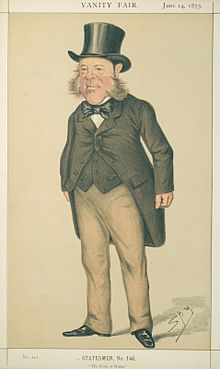
Williams-Wynn as caricatured by Spy (Leslie Ward) in Vanity Fair, June 1873
Lt-Col. Sir Watkin Williams-Wynn, 6th Baronet (22 May 1820 – 9 May 1885) was a Welsh Conservative Party politician who sat in the House of Commons from 1841 to 1885.
Biography

Williams-Wynn was born at the family's London property, the eldest son of Sir Watkin Williams-Wynn, 5th Baronet, and his wife Lady Henrietta Antonia Clive, eldest daughter of Edward Clive, 1st Earl of Powis. His brother-in-law, Edward Herbert, 2nd Earl of Powis, inherited Powis Castle in Wales. He was educated at Westminster School and Christ Church, Oxford. He was a cornet in the 1st Life Guards in 1839 and a lieutenant in 1842. He succeeded his father to the baronetcy on 6 January 1840. He was also at Magdalene College, Cambridge and graduated MA in 1842.
Williams-Wynn was elected Member of Parliament (MP) for Denbighshire in 1841 and held the seat until his death in 1885, aged 64. The seat had previously been held by his father, grandfather and great-grandfather, all of whom were also named Watkin Williams-Wynn.
Williams-Wynn was lieutenant colonel of the Montgomeryshire Yeomanry from 1844 to 1877 and of the 1st Denbighshire Rifle Volunteers from 1862 until his death. He was ADC to Queen Victoria in 1881. He hunted four days a week, having been appointed master of the hunt at 23. He was a director of the Great Western Railway. In 1845 he served as treasurer of the Salop Infirmary in Shrewsbury.
After Wynnstay was almost totally destroyed by fire in 1858, Sir Watkin rebuilt it between 1859 and 1865 on the same site, with Benjamin Ferrey as his architect.
Williams-Wynn married his cousin, Marie Emily Williams-Wynn, youngest daughter of Sir Henry Watkin Williams-Wynn, KCB, on 28 April 1852. He had two daughters, Marie Nesta Williams Wynn (23 October 1868 – 26 January 1883) who is commemorated by a stained glass window at Ruabon parish church, and Louisa Alexandra Williams Wynn (1864–1911), the sole heiress of the Wynnstay estate, who also married her cousin, Herbert Lloyd Watkin Williams-Wynn (1860–1944), who succeeded him as the 7th baronet on his death in 1885.
Coat of arms
References
- Emyr Gwynne Jones; Evan David Jones; Brynley Francis Roberts (1959). "Wynn family, of Wynnstay Ruabon". Dictionary of Welsh Biography. National Library of Wales. Retrieved 23 November 2021.
- ^ Debretts House of Commons and the Judicial Bench 1881
- ^ "Wynn, Sir Watkin Williams (WN842WW)". A Cambridge Alumni Database. University of Cambridge.
- Leigh Rayment's Historical List of MPs – Constituencies beginning with "D" (part 2)
- Army List.
- Keeling-Roberts, Margaret (1981). In Retrospect: A Short History of The Royal Salop Infirmary. North Shropshire Printing Company. p. xii. ISBN 0-9507849-0-7.
External links
| Parliament of the United Kingdom | ||
|---|---|---|
| Preceded byHugh Cholmondeley and William Bagot |
Member of Parliament for Denbighshire 1841–1885 With: William Bagot, to 1852 Robert Myddleton-Biddulph, 1852–1868 George Osborne Morgan, from 1868 |
Succeeded byGeorge Osborne Morgan and Sir Herbert Williams-Wynn |
| Baronetage of England | ||
| Preceded byWatkin Williams-Wynn | Baronet (of Gray's Inn) 1840–1885 |
Succeeded byHerbert Williams-Wynn |
- 1820 births
- 1885 deaths
- Alumni of Magdalene College, Cambridge
- Conservative Party (UK) MPs for Welsh constituencies
- British Life Guards officers
- UK MPs 1837–1841
- UK MPs 1841–1847
- UK MPs 1847–1852
- UK MPs 1852–1857
- UK MPs 1857–1859
- UK MPs 1859–1865
- UK MPs 1865–1868
- UK MPs 1868–1874
- UK MPs 1874–1880
- UK MPs 1880–1885
- Directors of the Great Western Railway
- Montgomeryshire Yeomanry officers
- Williams-Wynn baronets
- Williams-Wynn family
